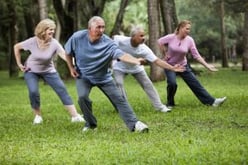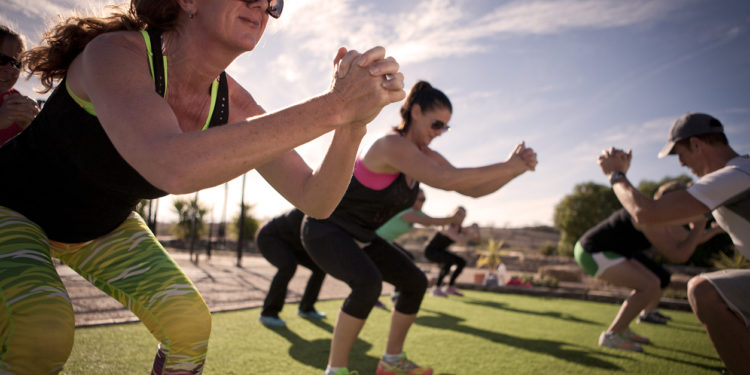Keeping our brains healthy is a trending topic that is surely grabbing our attention and the attention of our family, friends and clients. We’re all looking for ways to maintain our brain function and avoid such devastating diseases like Alzheimer’s and dementia.
We’ve probably all seen how Alzheimer's disease has impacted someone close to us. The Alzheimer’s Association notes that there is an estimated 5.7 million American’s living with Alzheimer’s disease. And that every 65 seconds someone develops Alzheimer’s disease in the United States, and that two-thirds of these cases are women.
Though the stats are staggering, to say the least, there are actions you can take to improve your odds for brain health longevity.
Here are 5 Tips for a Fit and Healthy Brain:
- Get Moving: Hopefully you exercise regularly, but even occasional bouts of aerobic exercise can help stimulate the neurochemicals needed to support and grow your brains neurons. Research has shown that aerobic exercise stimulates the production of brain-derived neurotrophic factor (BDNF), who’s expression is decreased in those with Alzheimer’s disease.2,3,9 And if you are a fan of high-intensity interval training (HIIT), it yields even higher levels of BDNF.7
 There are many benefits from tai chi.
There are many benefits from tai chi. - Challenge Your Brain: Engage in activities that challenge your brain – both cognitively and physically. Cognitive activities include things like playing board games, reading, playing music or even engaging in group discussions.10 Physical activities include dance, tai chi, walking, swimming and group exercise.10,11 These activities have been associated with a reduced risk of dementia.

- Breathe: Try deep breathing and meditation to bring stress levels under control. Various research projects have shown an association between stress (and elevated cortisol levels), depression, and Alzheimer’s. And if you are caring for someone with Alzheimer’s, that increased stress could be impacting you as well.
 A spice for flavor and health.
A spice for flavor and health. - Fuel Up: Research points to following a Mediterranean diet (which includes fruits, vegetables, olive oil, legumes, whole grains and fish) to lower Alzheimer’s disease risk, along with a menu of additional health perks associated with this diet.1,8 Eating leafy greens may also help to slow cognitive decline.5 Even turmeric, which contains curcumin (the spice behind curry), has been associated with better brain health. Focus on the healthy tastes you can add to your plate, rather than what you may be taking off. Your brain (and your body) will thank you.
- Sleep: You and your brain need deep sleep to clear away the day, and also a chance to remove the build up of amyloid plaques. Disturbed sleep not only impacts our cognitive functions, but has been linked to the development of Alzheimer’s disease.4,6 If disturbed sleep occurrences continue, tau protein levels also increase. The accumulation of these plaques and tau in the brain are key markers of Alzheimer’s.3 Interestingly, researchers are also looking at sleep disturbances as a possible early symptom of the disease.6
NASM and AFAA are proud to be partnered with the Women’s Alzheimer’s Movement, a global alliance of individuals, organizations, researchers, foundations, influencers and industry leaders committed to finding out why women are disproportionately affected by Alzheimer’s. By answering this question, they hope to unlock the other mysteries surrounding this mind-blowing disease and find a cure for all. For more information on the partnership and a chance to donate to the cause, visit nasm.org/move-for-minds.
If you want to help fight Alzheimers one training session at a time, consider applying your fitness skills with clients today.
References
- Berti, V., et al. 2018. Mediterranean diet and 3-year Alzheimer brain biomarker changers in middle-aged adults. Neurology, April 2018 DOI doi.org/10.1212/WNL.0000000000005527
- Coelho, F.G., et al. 2014. Acute aerobic exercise increases brain-derived neurotrophic factor levels in elderly with Alzheimer’s disease. Journal of Alzheimer’s Disease, 39(2): 401–08. ncbi.nlm.nih.gov/pubmed/24164734.
- DiGangi, J. 2018. Training the brain: The neuroscience of aerobic exercise. American Fitness, 36(1): 25-33. magazine.nasm.org/american-fitness-magazine/issues/american-fitness-magazine-winter-2018/training-the-brain-ceu-corner-the-neuroscience-of-aerobic-exercise
- Ju, Y.S., et al, 2017. Slow wave sleep disruption increases cerebrospinal fluid amyloid-β levels, Brain, 140(8): 2104-2111. academic.oup.com/brain/article/140/8/2104/3933862 doi.org/10.1093/brain/awx148
- Morris, M.C. et al, 2018. Nutrients and bioactives in green leafy vegetables and cognitive decline Prospective study. Neurology, 16;90(3): e214-e222. ncbi.nlm.nih.gov/pubmed/29263222
- Musiek, E., et al, 2018. Circadian rest-activity pattern changes in aging and preclinical Alzheimer disease. JAMA Neurology, 75(5): 582-590. doi:10.1001/jamaneurol.2017.4719
- Saucedo Marquez, C.M., et al. 2015. High-intensity interval training evokes larger serum BDNF levels compared to intense continuous exercise. Journal of Applied Physiology, 119, 1363–73. jap.physiology.org/content/jap/early/2015/10/06/japplphysiol.00126.2015.full.pdf.
- Scarmeas, N., et al, 2016. Mediterranean diet and risk for alzheimer’s disease. Annals of Neurology, 59(6): 912-921. ncbi.nlm.nih.gov/pmc/articles/PMC3024594/
- Seifert, et al. 2010. Endurance training enhances BDNF release from the human brain. American Journal of Physiology: Regulatory, Integrative and Comparative Physiology, 298(2): R372–7. ncbi.nlm.nih.gov/pubmed/19923361.
- Verghese,J., et al, 2003. Leisure activities and the risk of dementia in the elderly. New England Journal of Medicine, 348:2508-2516. nejm.org/doi/full/10.1056/NEJMoa022252
- Wayne, P.M., et al. 2014. The impact of tai chi on cognitive performance in older adults: A systematic review and meta-analysis. Journal of the American Geriatric Society, 62(2): 25-39. ncbi.nlm.nih.gov/pmc/articles/PMC4055508/
















